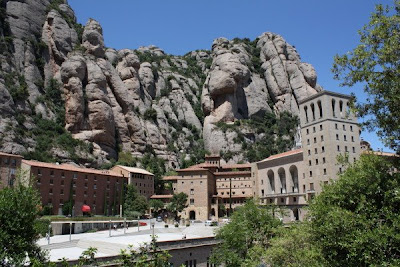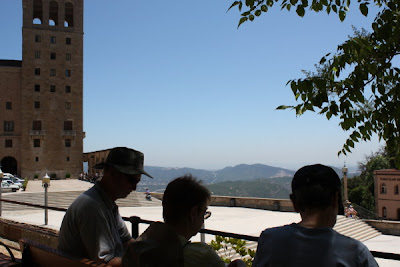Here, in the 9th century shepherd children saw a bright light descend from the sky and heard angels sing, drawing them to a cave where they discovered a statue of the Madonna, said to have been carved by St. Luke, brought to Spain, and hidden here from the Moors. Here, a monastery founded in the 11th century, high up the cliff, became a major pilgrimage site for veneration of that Black Madonna (still on display today). Here, the knight who slew the daughter of Wilfred the Hairy fled, filled with remorse, to become the first hermit of Montserrat. Here, a dragon let loose in Catalunya by the Saracens, flew when it was under attack, before Wilfred the Hairy, or his father (accounts differ), finally slew it (the exploit celebrated in the portal sculpture at the Barcelona cathedral). On its slopes in 1808 a thousand Catalan irregulars defeated four thousand of Napoleon’s troops at the battle of Bruc because the sounds of a little drummer boy echoing off the rocks misled the troops into thinking they were facing a much larger force. And here Wagner, never one to overlook a good myth, set his opera Parsifal.
We had driven past Montserrat on our trips to France and Andalucía, but had never visited the place itself until we went last week with Cheryl and Charles. Access is by cable car, which offers great views of the countryside below.
 According to a plaque, the cable car system was built in 1930 by a company from Leipzig, Germany; judging by appearance the cable car itself may be original equipment.
According to a plaque, the cable car system was built in 1930 by a company from Leipzig, Germany; judging by appearance the cable car itself may be original equipment.The monastery itself was destroyed by Napoleonic troops in 1812 (their revenge on the little drummer boy?). The rebuilt complex is itself of little aesthetic interest, but the natural setting is spectacular.

 We first visited the basilica for the mid-day concert of Escolonia, the monastery's boys choir that was founded in the 13th century. Which was followed by the performance of a visiting choir. From Cincinnati.
We first visited the basilica for the mid-day concert of Escolonia, the monastery's boys choir that was founded in the 13th century. Which was followed by the performance of a visiting choir. From Cincinnati. Afterwards we enjoyed a picnic with a view.
Afterwards we enjoyed a picnic with a view. Well fed, we took a funicular close to the top of the ridge, from where one can look down on the monastery and countryside further below.
Well fed, we took a funicular close to the top of the ridge, from where one can look down on the monastery and countryside further below.
 Hiking trails lead off in various directions, with views of the rock formations and surrounding country.
Hiking trails lead off in various directions, with views of the rock formations and surrounding country.
 Cheryl and Charles pause on the trail.
Cheryl and Charles pause on the trail. Many of the trails lead to small hermitages scattered among the rock outcroppings.
Many of the trails lead to small hermitages scattered among the rock outcroppings. It was not difficult to understand why the Catalans are so fond of this place.
It was not difficult to understand why the Catalans are so fond of this place.
No comments:
Post a Comment